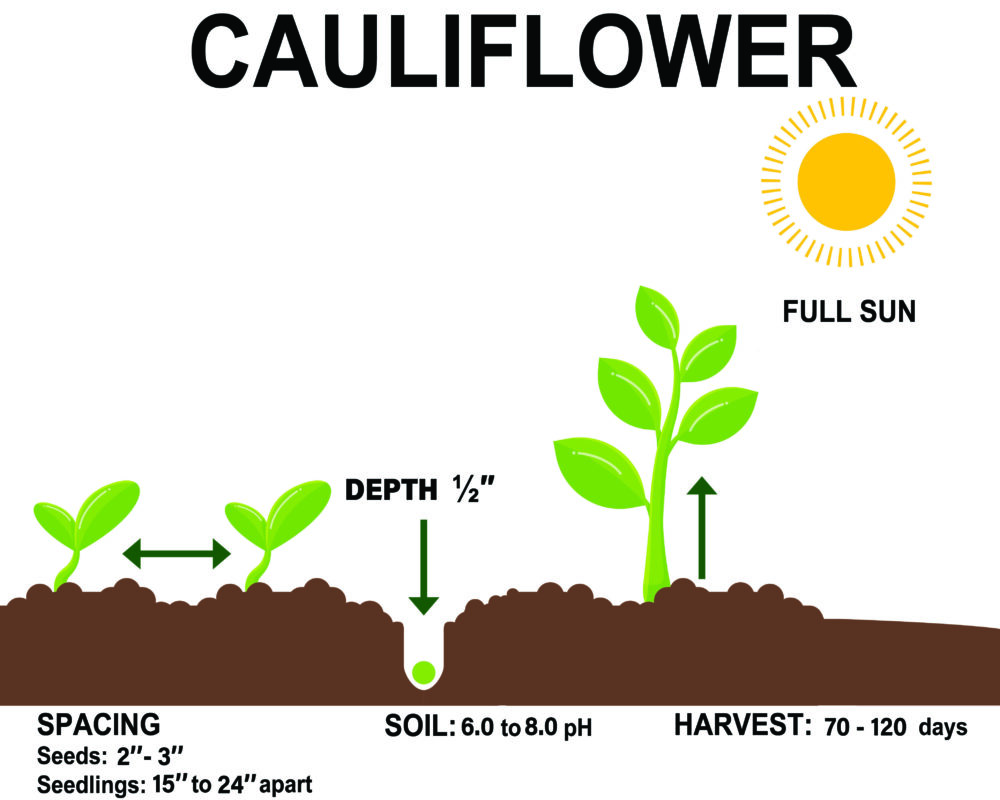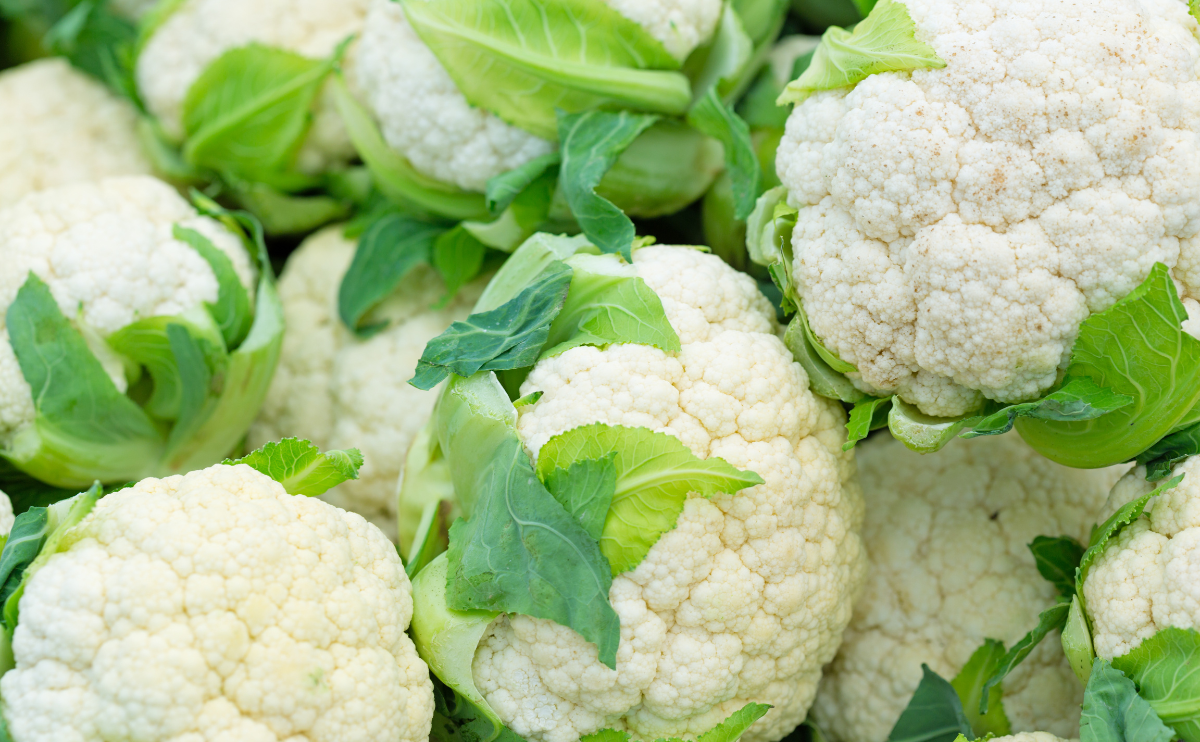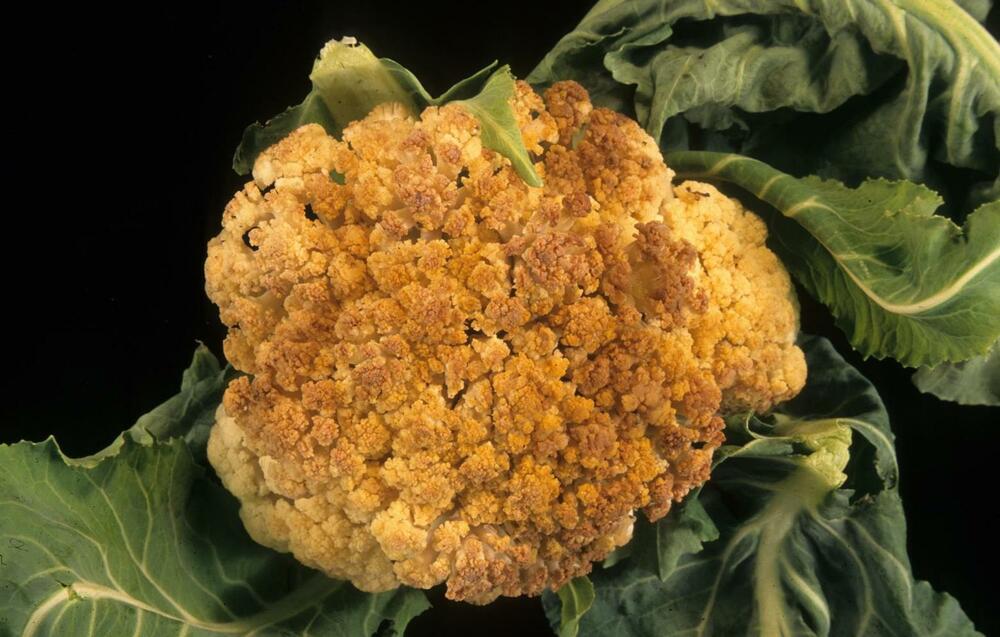Cauliflower (Brassica oleracea, Botrytis group) is one of the many cabbage-related cole crops that revel in cool weather. Mark Twain called it “a cabbage with a college education,” but it’s more than just a cabbage with airs. Cauliflower has a very distinct nuttiness and is similar to broccoli in flavor. The main edible part of both cauliflower and broccoli are the heads, formed from undeveloped flower buds.
Cauliflower is not the easiest vegetable to grow, because it is very sensitive to temperature changes. However, with a little TLC, it can be a very rewarding vegetable for your garden. You’ll have many more variety options if you start your cauliflower from seed. All varieties, but especially white cauliflower, need to be blanched, by covering the head with its leaves. The purple varieties get their color from anthocyanin, an antioxidant. Unfortunately, both the color and the benefits disappear with cooking. Orange cauliflower is the result of a happy accident (a mutation). It gets its color from a relatively high content of beta-carotene.
Cauliflower has thick, oval leaves with pronounced mid-ribs and veins. The leaves and stem of cauliflower are both edible. The cauliflower head is composed of tightly packed undeveloped flower buds, often referred to as curds. The actual flowers of the cauliflower are the familiar 4 petals in a cross shape that give this family of vegetables the name cruciferous, which appears when the plant bolts.
Cauliflower plants like cool (but not cold) weather and are best planted in early spring (for an early summer harvest) or in midsummer (for a fall harvest). They have a moderately slow growth rate and are ready to harvest in two to three months from planting, depending on the type.

| Botanical Name | Brassica oleracea (Botrytis group) |
| Common Name | Cauliflower |
| Plant Type | Biennial, grown as an annual |
| Mature Size | 12-30 in. tall, 12-24 in. wide |
| Sun Exposure | Full sun |
| Soil Type | Rich, well-draining |
| Soil pH | Neutral (6.5 to 7.5) |
| Bloom Time | Spring, fall |
| Flower Color | White, orange, purple, green |
| Hardiness Zones | 2-11 (USDA) |
| Native Area | Europe |

When to Plant?
This will be determined by your planting zone. There is a final frost date for each area. As a result, you can plan your gardening activities around this date. Check our Frost Dates Across North America: First & Last Frost Dates Chart. However, the date will not be the same for every plant.
How to Plant
Soil needs to be very rich in organic matter.
Start planting cauliflower seeds 4 – 5 weeks before the date of the last spring frost.
Sow in rows 3 to 6 inches apart in all directions and up to ½ inch deep.
The plant requires regular watering.
You can transplant cauliflower seedlings 2 – 4 weeks before the date of the last spring frost.

Set plants from 15″ to 24″ apart and 30″ between rows. Extreme cold can slow down growth or even form button-sized heads. In early spring, be prepared to protect your plants from frost. Plant your fall crop 6 – 8 weeks before the first fall frost date, but always after daytime temperatures regularly drop below 75°F. You can add mulch to retain moisture. Cauliflower needs 2 inches of water regularly every week. Apply a high nitrogen fertilizer about 3 – 4 weeks after transplanting to improve plant growth,.
How to Cultivate
Water – Do not let the ground dry out. Organic mulch will help keep the soil cool and moist, suppressing weeds.
Soil – rich, well-drained, 6.5 to 8.0 pH
Spacing – seeds – 2″ – 3″
Seedling – 15″ – 24″
Seed life: 5 years
Sun: Full sun
Germination: 4 – 7 days, 45°F to 85°F
Day to Harvest: 70 – 120 days
Frost tolerant: yes
How to Harvest
Cauliflower plants are ready to harvest in about 70 – 100 days.
Compact, hard, and smooth cauliflower heads should be harvested while still white before yellow buds start to open.
The cauliflower heads should be about 5 – 7 inches in diameter.
To collect cauliflower, cut off the stem a few inches below the head using a big knife.
It is necessary to keep some of the leaves around the head intact to hold the cauliflower head together.
If the cauliflower has gone bad, has brown spots, begins to smell, and gets a slimy structure, it should be thrown away.
Hydroponics
Germination: To start growing cauliflower hydroponically, you will first need to germinate the seeds. You can do this by placing the seeds on a moist paper towel in a dark and warm location until they sprout. Once the seeds have sprouted, you can transfer them to your hydroponic system.
pH range: The pH range for growing cauliflower hydroponically should be between 5.5 and 6.5. You can test the pH levels using a pH meter or pH testing kit and adjust it by adding pH up or pH down solutions.
EC: The electrical conductivity (EC) range for growing cauliflower hydroponically should be between 1.2 and 2.2 mS/cm. EC refers to the concentration of dissolved salts in the water.
PPM: The parts per million (PPM) range for growing cauliflower hydroponically should be between 840 and 1540 PPM. PPM is a measurement of the concentration of nutrients in the water.
Humidity: The humidity level for growing cauliflower hydroponically should be around 60-70%. You can use a hygrometer to measure the humidity levels and adjust it by adding or reducing the amount of water in your system.
Light hours: Cauliflower plants need 8-10 hours of light per day to grow properly. You can use grow lights to provide the necessary light for your plants.
Temperature air: The ideal air temperature for growing cauliflower hydroponically is between 60 and 70 degrees Fahrenheit (15 to 21 degrees Celsius).
Temperature water: The water temperature for growing cauliflower hydroponically should be between 65 and 75 degrees Fahrenheit (18 to 24 degrees Celsius). You can use a water heater or a chiller to adjust the water temperature as needed.
In summary, growing cauliflower hydroponically involves germinating the seeds, maintaining proper pH levels, EC, PPM, humidity, light hours, and temperature for both air and water. By following these guidelines, you can ensure that your cauliflower plants grow healthy and strong.



